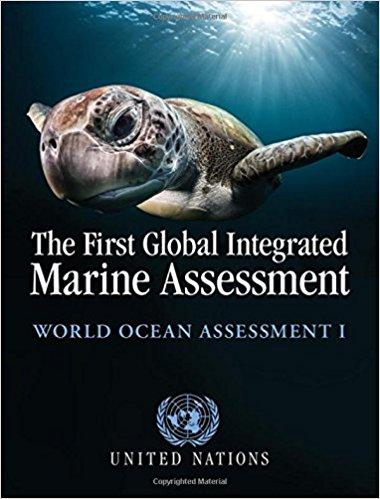First World Ocean Assessment (WOA I)
The First Global Integrated Marine Assessment, also known as the “World Ocean Assessment I”, is the outcome of the first cycle of the Regular Process for Global Reporting and Assessment of the State of the Marine Environment, including Socioeconomic Aspects. Hundreds of scientists from many countries, representing various disciplines and steered by a 22-member Group of Experts, examined the state of knowledge of the world’s oceans and the ways in which humans benefit from and affect them. Their findings indicate that the oceans’ carrying capacity is near or at its limit. It is clear that urgent action on a global scale is needed to protect the world’s oceans from the many pressures they face. The first World Ocean Assessment provides an important scientific basis for the consideration of ocean issues by Governments, intergovernmental processes, and all policy-makers and others involved in ocean affairs. The Assessment reinforces the science-policy interface and establishes the basis for future assessments. Together with future assessments and related initiatives, it will help in the implementation of the recently adopted 2030 Agenda for Sustainable Development, particularly its ocean related goals.
- Outline of the World Ocean Assessment (Arabic | Chinese | English | French
| Russian | Spanish) - Revised Draft Timetable
- First World Ocean Assessment - GRID Arendal Story map
- Guidance for Contributors
- Website for the preparation of the World Ocean Assessment (Archive)

Cover photo: Gregory Lecoeur, United Nations World Oceans Day Photo Competition, (www.unworldoceansday.org)
On 23 December 2015, the United Nations General Assembly adopted resolution 70/235 on “Oceans and the law of the sea,” in which it welcomed with appreciation the first global integrated marine assessment and approved its summary.
Foreword by the Secretary-General of the United Nations
Foreword by the Secretary-General of the United Nations
Preface by the Joint Coordinators of the Group of Experts of the Regular Process
Preface by the Joint Coordinators of the Group of Experts of the Regular Process
Frontmatter
Frontmatter
Part I Summary
Part I Summary
Part II The Context of the Assessment
Part II The Context of the Assessment
Part III Assessment of Major Ecosystem Services from the Marine Environment (other than provisioning services)
Part III Assessment of Major Ecosystem Services from the Marine Environment (other than provisioning services)
- Chapter 3 Scientific Understanding of Ecosystem Services
- Chapter 4 The Ocean’s Role in the Hydrological Cycle
- Chapter 5 Sea/Air Interaction
- Chapter 6 Primary Production, Cycling of Nutrients, Surface Layer and Plankton
- Chapter 7 Calcium Carbonate Production and Contribution to Coastal Sediments
- Chapter 8 Aesthetic, Cultural, Religious and Spiritual Ecosystem Services Derived from the Marine Environment
- Chapter 9 Conclusions on Major Ecosystem Services Other than Provisioning Services
Part IV Assessment of the Cross-cutting Issues: Food Security and Food Safety
Part IV Assessment of the Cross-cutting Issues: Food Security and Food Safety
Part V Assessment of Other Human Activities and the Marine Environment
Part V Assessment of Other Human Activities and the Marine Environment
- Chapter 17 Shipping
- Chapter 18 Ports
- Chapter 19 Submarine Cables and Pipelines
- Chapter 20 Coastal, Riverine and Atmospheric Inputs from Land
- Chapter 21 Offshore Hydrocarbon Industries
- Chapter 22 Other Marine-Based Energy Industries
- Chapter 23 Offshore Mining Industries
- Chapter 24 Solid Waste Disposal
- Chapter 25 Marine Debris
- Chapter 26 Land/Sea Physical Interaction
- Chapter 27 Tourism and Recreation
- Chapter 28 Desalinization
- Chapter 29 Use of Marine Genetic Resources
- Chapter 30 Marine Scientific Research
- Appendix
- Chapter 31 Conclusions on Other Human Activities
- Chapter 32 Capacity-Building in Relation to Human Activities Affecting the Marine Environment
Part VI Assessment of Marine Biological Diversity and Habitats
Part VI Assessment of Marine Biological Diversity and Habitats
Section A — Overview of Marine Biological Diversity
Section A — Overview of Marine Biological Diversity
- Chapter 34 Global Patterns in Marine Biodiversity
- Chapter 35 Extent of Assessment of Marine Biological Diversity
- Chapter 36. Overall Status of Major Groups of Species and Habitats
Section B — Marine Ecosystems, Species and Habitats Scientifically Identified as Threatened, Declining or Otherwise...
Section B — Marine Ecosystems, Species and Habitats Scientifically Identified as Threatened, Declining or Otherwise...
I. Marine Species
II. Marine Ecosystems and Habitats
II. Marine Ecosystems and Habitats
- Chapter 42 Cold-Water Corals
- Chapter 43 Tropical and Sub-Tropical Coral Reefs
- Chapter 44 Estuaries and Deltas
- Chapter 45 Hydrothermal Vents and Cold Seeps\
- Chapter 46 High-Latitude Ice and the Biodiversity Dependent on it
- Chapter 47 Kelp Forests and Seagrass Meadows
- Chapter 48 Mangroves
- Chapter 49 Salt Marshes
- Chapter 50 Sargasso Sea
- Chapter 51 Biological Communities on Seamounts and Other Submarine Features Potentially Threatened by Disturbance

